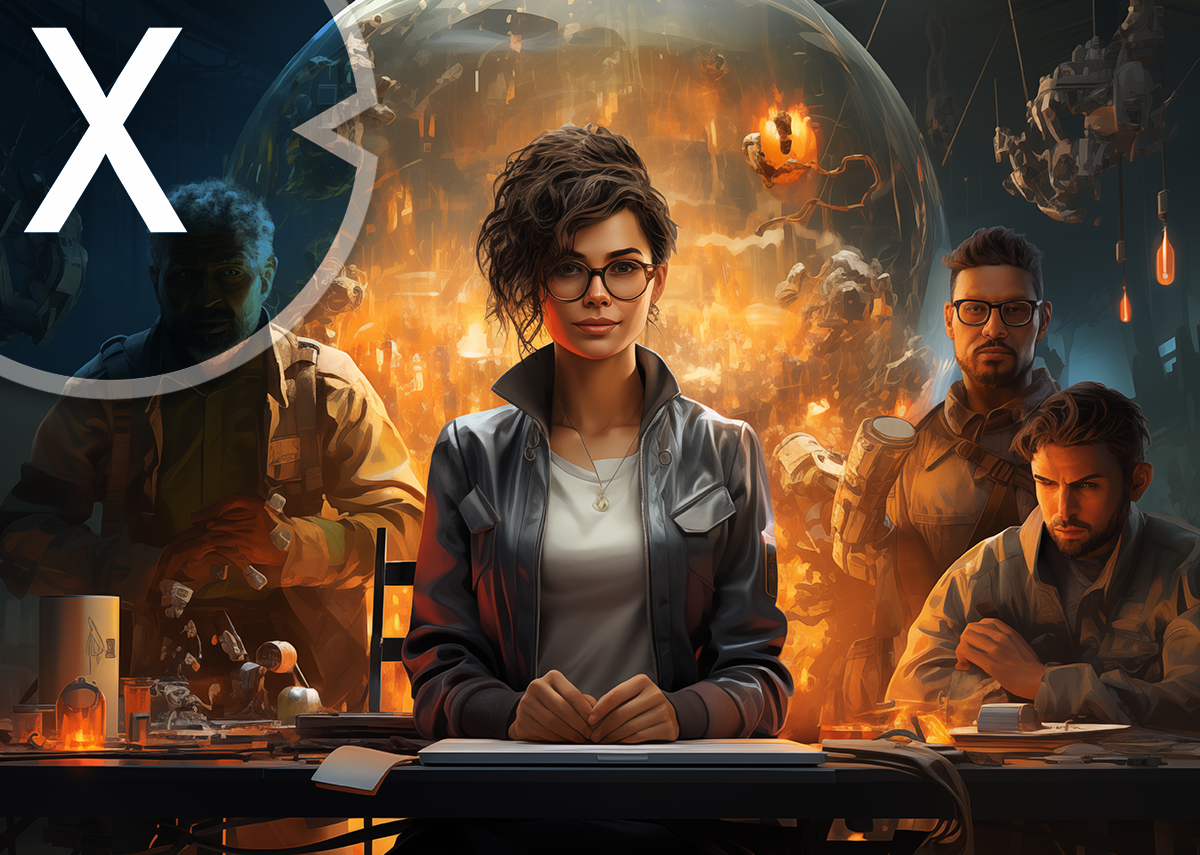Bringing the sun to earth with nuclear fusion: Why Germany wants to build the world's first fusion power plant
Xpert pre-release
Language selection 📢
Published on: October 5, 2025 / Updated on: October 5, 2025 – Author: Konrad Wolfenstein

Bringing the sun to Earth with nuclear fusion: Why Germany wants to build the world's first fusion power plant – Image: Xpert.Digital
German start-ups in fusion fever: After the US breakthrough, the race for the energy of the future has begun - That's why Germany now has the best chance of a fusion power plant
What is nuclear fusion and why is it so important?
Nuclear fusion is considered one of the most promising ways to solve the global energy problem. In this process, light atomic nuclei fuse together, releasing enormous amounts of energy, just as happens in the sun. Unlike conventional nuclear fission, which is used in nuclear power plants, fusion does not produce long-lived radioactive waste and cannot get out of control.
The decisive breakthrough came in 2022 at the Lawrence Livermore Laboratory in California, when, for the first time, more energy was produced through nuclear fusion than consumed. This scientific achievement transformed the dream of infinite energy from a theoretical possibility into a tangible reality. Since then, there has been an intense global race to build the first functional fusion reactor.
Why is Germany a leading candidate for the first fusion power plant?
Germany has excellent prerequisites for a leading role in nuclear fusion. The industrial base is already in place, as are highly qualified specialists and a strong research landscape. Interestingly, even the American breakthrough in Livermore was achieved with German technology – the special glass for the laser system came from the Mainz-based company Schott, and the mechanical engineering company Trumpf was also involved.
The German government recognized the potential and adopted the Fusion Action Plan in October 2025. This plan calls for over two billion euros to be invested in fusion research by 2029. The stated goal is ambitious: Germany is to host the world's first commercial fusion power plant.
Which German companies are leaders in fusion research?
Three German startups have established themselves as pioneers in nuclear fusion and are working on realizing the dream of clean energy with different technological approaches. Munich-based Marvel Fusion focuses on laser fusion and has already raised €385 million. However, the company plans to relocate part of its development to the United States, raising questions about the future of the German know-how.
Proxima Fusion, also based in Munich, is a spin-off from the Max Planck Institute for Plasma Physics and focuses on stellarator technology. The company received record funding of €130 million in 2025, the largest private investment in European nuclear fusion. Focused Energy from Darmstadt is working on inertial fusion using laser technology and has raised $200 million. RWE has invested €10 million as a strategic partner.
How does nuclear fusion work technically?
The practical implementation of nuclear fusion is one of the greatest technical challenges of our time. The hydrogen isotopes deuterium and tritium serve as fuel. Deuterium is abundant in seawater, while tritium is very rare and must be produced primarily in fusion reactors themselves by irradiating lithium with neutrons.
To enable fusion, temperatures of approximately 150 million degrees Celsius must be reached. Under these extreme conditions, the atomic nuclei fuse to form helium, releasing 17.6 megaelectronvolts per reaction. The energy contained in one kilogram of deuterium-tritium mixture is equivalent to that of 55,000 barrels of diesel or 18,630 tons of lignite.
What are the biggest technical challenges?
The development of a functional fusion power plant faces several critical challenges. Tritium production is one of the most challenging, as this fuel is rarely found in nature and must be produced in the power plant itself. Scientists are working on breeding tritium from lithium using neutron bombardment, but this technology is not yet mature.
Another problem is the extremely strong magnets required to confine the hot plasma. These high-temperature superconducting magnets are technically extremely complex and must function reliably to control the plasma. Furthermore, materials must be developed that can withstand the intense neutron radiation without losing their structural integrity.
What progress has been made in German fusion research?
German fusion research has achieved remarkable successes in recent years. The Wendelstein 7-X in Greifswald, the world's largest stellarator facility, set a new world record for the so-called triple product in 2025. This product of particle density, temperature, and energy confinement time is the key parameter for progress in fusion physics.
A new record of over 43 seconds was achieved, even surpassing previous records for tokamak systems. More than 700 project proposals for work on the facility were submitted, of which approximately 200 received the highest priority. These successes underline Germany's position as a leading research nation in nuclear fusion.
What political measures is the federal government planning?
The Fusion Action Plan, adopted in October 2025, encompasses eight specific areas of action. Research funding is to be strengthened, with funding increased to up to €1.7 billion under "Fusion 2040." In addition, a fusion ecosystem of science and industry is to be established to promote knowledge transfer and establish value chains.
A key point is the planned regulatory reform. In the US and the UK, nuclear fusion is already regulated differently than nuclear fission, which provides greater planning security for private investments. Germany is still lagging behind in this regard, which is why fusion companies are demanding a corresponding adjustment of the regulations.
What do the German merger companies demand from politicians?
The three leading German merger companies have made clear demands of policymakers in a joint position paper. They are calling for three billion euros in government funding to close the funding gap in the deep tech sector. This sum may seem high, but it would flow directly into German industry, as the expensive lasers and magnets would have to be manufactured here.
A key point of criticism is Germany's approach to new technologies. As one industry representative noted, Germany typically sets regulations before any development even begins. This regulatory frenzy makes innovation unnecessarily expensive and slow. Companies are calling for a less bureaucratic approach, one that has already been successfully applied to other technologies.
Our EU and Germany expertise in business development, sales and marketing
Industry focus: B2B, digitalization (from AI to XR), mechanical engineering, logistics, renewable energies and industry
More about it here:
A topic hub with insights and expertise:
- Knowledge platform on the global and regional economy, innovation and industry-specific trends
- Collection of analyses, impulses and background information from our focus areas
- A place for expertise and information on current developments in business and technology
- Topic hub for companies that want to learn about markets, digitalization and industry innovations
The 2030s as a starting point? When fusion power plants will actually produce electricity
When will the first fusion power plants go into operation?
The timelines for the first operational fusion power plants vary depending on the technology and company. German startups plan to commission their first reactors as early as the early 2030s. However, these early plants will not yet be commercially viable, but will serve as demonstrations of the technology.
Experts expect truly commercial and economically viable fusion power plants to be ready by the end of the 2030s or the beginning of the 2040s. The international ITER project in France, which was originally intended to serve as a pioneer, is struggling with significant delays and will not begin operating with the relevant deuterium-tritium fuel until 2039.
Is nuclear fusion really safe and environmentally friendly?
Nuclear fusion offers decisive safety advantages over conventional nuclear fission. An uncontrolled chain reaction is physically impossible because there are only a few grams of fuel in the reactor. If the power supply fails, the reaction automatically stops. The radioactive fuels also have significantly shorter half-lives than the fission products of conventional nuclear power plants.
Nevertheless, fusion also produces radioactive waste, primarily from the activation of the reactor walls by neutron radiation. These materials must be safely stored for several hundred years, but are less problematic than highly radioactive nuclear waste. Scientists are working on special low-activatability materials that could be recycled after 50 to 100 years.
What economic challenges exist?
The economic viability of fusion power plants has not yet been conclusively proven. Experts assume that the costs will initially be comparable to or even higher than those of conventional nuclear power plants. Due to its high investment costs, a fusion power plant must be operated continuously to be profitable.
A potential problem is that fusion power plants are designed as baseload power plants, while the energy system of the future requires more flexible, controllable plants. In a system dominated by renewable energies, power plants must be able to be ramped up and shut down quickly. Large, complex fusion plants are not ideally suited for this.
How does fusion fit into the future energy system?
The role of nuclear fusion in the energy system of the future is controversial. While proponents argue that fusion power plants are important as a reliable baseload source, critics see them as too inflexible for a system with a high proportion of renewable energy. Fusion power plants could, however, be used for energy-intensive industrial processes and the production of green hydrogen.
An important aspect is that nuclear fusion is not intended to replace renewable energies, but rather to complement them. Energy demand will increase significantly in the coming decades, not least due to data centers and digitalization. In this growing market, various clean energy sources can coexist without displacing one another.
What role does international competition play?
Germany is in intense international competition for leadership in nuclear fusion. In addition to the United States, which set an important milestone with the Livermore breakthrough, China, Japan, and other countries are also working intensively on the technology. The delayed ITER project demonstrates that even established international collaborations are struggling with challenges.
German companies emphasize that their main competitor is time, not other companies. If one company succeeds in bringing the technology to market maturity, it helps the entire industry. Nevertheless, it is clear that Germany must act quickly to avoid squandering its technological lead and to prevent German know-how from being commercialized in other countries.
What is the job creation potential of the fusion industry?
Nuclear fusion could become a significant economic factor in Germany. The multi-billion euro investment would primarily benefit German industry, as lasers, magnets, and other components would have to be produced here. Unlike other energy technologies, where manufacturing capacity has often shifted abroad, this would offer the opportunity to establish an entire value chain in Germany.
The fusion industry would not only create direct jobs, but also jobs for suppliers and service providers. Regions like the former power plant site in Biblis could benefit from repurposing it for fusion facilities, replacing lost jobs with new, future-proof jobs. The competence and excellence centers planned by the federal government are intended to provide additional impetus for innovation.
What risks and challenges remain?
Despite all the progress, significant risks remain in the development of nuclear fusion. The technology is not yet mature, and many critical problems remain unresolved. Materials development for neutron-resistant materials is still in its early stages, and tritium production on an industrial scale is unproven.
Another risk lies in financing. The required investment is enormous, and private investors often shy away from the high technical risk. Without massive government support, development will not be possible. At the same time, there is a risk that the technology will prove uneconomical or will be overtaken by other energy sources.
What does all this mean for Germany’s energy future?
Nuclear fusion represents a strategic opportunity for Germany to reduce global energy dependence on natural resources and assume a technological leadership role. The Federal Government's Action Plan demonstrates that policymakers have recognized the potential and are willing to invest significant resources.
However, nuclear fusion will not be available in time for the current energy transition. Fusion power plants will not be able to play a significant role by 2045, the target date for Germany's climate neutrality. The technology is more of an investment in the energy supply for the second half of the century.
Opportunities and challenges in balance
Germany has a realistic chance of playing a leading role in the global race for the first commercial nuclear fusion. The existing industrial base, research excellence, and political commitment create favorable conditions. German companies are working on various promising approaches and have already attracted significant private investment.
At the same time, the challenges should not be underestimated. The technical problems are complex, the financing gaps are large, and international competition is fierce. There is a risk that Germany will once again develop a technology that will then be commercialized elsewhere. Without decisive political action and simplified regulation, Germany's lead could quickly be lost.
The next few years will be crucial. If Germany sets the right course, it could indeed be the first country to harness the power of the stars for Earth's energy supply. This would not only be a scientific triumph, but also an important building block for long-term energy security and climate protection.
Your global marketing and business development partner
☑️ Our business language is English or German
☑️ NEW: Correspondence in your national language!
I would be happy to serve you and my team as a personal advisor.
You can contact me by filling out the contact form or simply call me on +49 89 89 674 804 (Munich) . My email address is: wolfenstein ∂ xpert.digital
I'm looking forward to our joint project.
☑️ SME support in strategy, consulting, planning and implementation
☑️ Creation or realignment of the digital strategy and digitalization
☑️ Expansion and optimization of international sales processes
☑️ Global & Digital B2B trading platforms
☑️ Pioneer Business Development / Marketing / PR / Trade Fairs
🎯🎯🎯 Benefit from Xpert.Digital's extensive, fivefold expertise in a comprehensive service package | R&D, XR, PR & SEM

AI & XR 3D Rendering Machine: Fivefold expertise from Xpert.Digital in a comprehensive service package, R&D XR, PR & SEM - Image: Xpert.Digital
Xpert.Digital has in-depth knowledge of various industries. This allows us to develop tailor-made strategies that are tailored precisely to the requirements and challenges of your specific market segment. By continually analyzing market trends and following industry developments, we can act with foresight and offer innovative solutions. Through the combination of experience and knowledge, we generate added value and give our customers a decisive competitive advantage.
More about it here:























